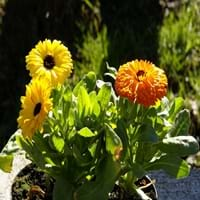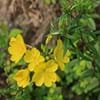Life Span
Perennial
Perennial
Type
Perennial
Flowering Plants
Origin
Northeastern United States, Mid-Atlantic United States, Southeastern United States, North-Central United States, Central United States, South-Central United States
Europe, Mediterranean
Types
Apricot Delight, Copper canyon
Kablouna Gold, Fiesta Gitana, Art Shades
Number of Varieties
Not Available
Habitat
Roadsides, sand dunes, Waste areas
gardens, Roadsides, Waste areas, wastelands
USDA Hardiness Zone
5-8
3-9
Sunset Zone
1a, 1b, 2a, 2b, 3a, 3b, 4, 5, 6, 7, 8, 9, 10, 11, 12, 13, 14, 15, 16, 17, 18, 19, 20, 21, 22, 23, 24
A2, A3, H1, 1a, 1b, 2a, 2b, 3a, 3b, 4, 5, 6, 7, 8, 9, 10, 11, 12, 13, 14, 15, 16, 17, 18, 19, 20, 21, 22, 23, 24
Habit
Clump-Forming
Clump-Forming
Flower Color
Yellow
Yellow, Orange, Bronze, Ivory
Flower Color Modifier
Bicolor
Bicolor
Fruit Color
Tan
Green, Tan
Leaf Color in Spring
Green
Green
Leaf Color in Summer
Green
Green
Leaf Color in Fall
Green
Green
Leaf Color in Winter
Light Green
Light Green
Leaf Shape
Oblong
Oblong-lanceolate
Plant Season
Summer
Early Autumn, Spring, Summer
Sunlight
Full Sun, Partial Sun
Full Sun, Partial shade, Partial Sun
Type of Soil
Loam, Sand
Well drained
The pH of Soil
Acidic, Neutral, Alkaline
Acidic, Alkaline, Neutral
Soil Drainage
Well drained
Average
Bloom Time
Early Summer, Summer, Late Summer
Early Winter
Tolerances
Variety of soil types
Drought
Where to Plant?
Container, Ground, Pot
Ground, Pot
How to Plant?
Divison, Seedlings, Stem Planting
Seedlings, Transplanting
Plant Maintenance
Low
Medium
Watering Requirements
Average Water Needs, Do Not over Water, Never Over-water, Requires regular watering, Water more in summer
Requires regular watering
In Summer
Lots of watering
Lots of watering
In Spring
Moderate
Moderate
In Winter
Average Water
Average Water
Soil pH
Acidic, Neutral, Alkaline
Acidic, Alkaline, Neutral
Soil Type
Loam, Sand
Moist, Well drained
Soil Drainage Capacity
Well drained
Not Available
Sun Exposure
Full Sun, Partial Sun
Partial shade
Pruning
Remove damaged leaves, Remove dead branches, Remove dead leaves, Remove dead or diseased plant parts
Cut or pinch the stems, Remove damaged leaves, Remove dead branches, Remove dead leaves
Fertilizers
All-Purpose Liquid Fertilizer, fertilize in growing season
All-Purpose Liquid Fertilizer
Pests and Diseases
Slugs, Snails
Red blotch
Plant Tolerance
Variety of soil types
Drought
Flower Petal Number
Single
Double, Semi-Double
Foliage Texture
Fine
Medium
Foliage Sheen
Matte
Matte
Attracts
Insects
Beetles, Butterflies, Flying insects
Allergy
Abdominal pain, Constipation, Diarrhea, Skin irritation
Dizziness, Itchiness, Nausea, Skin rash, Swelling
Aesthetic Uses
Beautification, Borders, Landscape Designing, Showy Purposes
Showy Purposes
Beauty Benefits
Good for skin, Making cosmetics, Stops hair loss
Good for skin and hair, Skin cleanser, Skin Problems, used as a dye
Environmental Uses
Air purification, Food for insects, Versatility
Air purification
Medicinal Uses
Eczema
Curing mumps and measles, Cuts, Reduces toothache, Surgical wounds, Throat infection, Ulcers
Part of Plant Used
Root
Flowers, Leaves, Root
Other Uses
Decoration Purposes, Medicinal oil, Showy Purposes, Used as Ornamental plant, Used for its medicinal properties
Cosmetics, Sometimes used for making wine, Used as an insecticide, Used as essential oil, Used As Food, Used as Ornamental plant, Used in salads
Used As Indoor Plant
Yes
Insignificant
Used As Outdoor Plant
Yes
Yes
Garden Design
Edging, Feature Plant, Groundcover, Mixed Border
Groundcover, Showy Tree
Botanical Name
OENOTHERA 'Cold Crick'
CALENDULA officinalis
Common Name
Suncups, sundrops
Pot Marigold
In Hindi
Evening Primrose
Pot Marigold
In German
Evening Primrose
Ringelblume
In French
onagre
pot Marigold
In Spanish
onagra
Caléndula
In Greek
Νυχτολούλουδο
καλέντουλα
In Portuguese
Evening Primrose
pot Marigold
In Polish
wiesiołka
Pot Marigold
In Latin
vespere Primrose
Zinnia Pot
Phylum
Magnoliophyta
Vascular plant
Class
Magnoliopsida
Magnoliopsida
Family
Onagraceae
Asteraceae
Genus
Oenothera
Calendula
Clade
Angiosperms, Eudicots, Rosids
Angiosperms, Asterids, Eudicots
Tribe
Onagreae
Calenduleae
Subfamily
Onagroideae
Asteroideae
Season and Care of Evening Primrose and Pot Marigold
Season and care of Evening Primrose and Pot Marigold is important to know. While considering everything about Evening Primrose and Pot Marigold Care, growing season is an essential factor. Evening Primrose season is Summer and Pot Marigold season is Summer. The type of soil for Evening Primrose is Loam, Sand and for Pot Marigold is Well drained while the PH of soil for Evening Primrose is Acidic, Neutral, Alkaline and for Pot Marigold is Acidic, Alkaline, Neutral.
Evening Primrose and Pot Marigold Physical Information
Evening Primrose and Pot Marigold physical information is very important for comparison. Evening Primrose height is 1.00 cm and width 0.10 cm whereas Pot Marigold height is 80.00 cm and width 91.44 cm. The color specification of Evening Primrose and Pot Marigold are as follows:
Evening Primrose flower color: Yellow
Evening Primrose leaf color: Green
Pot Marigold flower color: Yellow, Orange, Bronze and Ivory
- Pot Marigold leaf color: Green
Care of Evening Primrose and Pot Marigold
Care of Evening Primrose and Pot Marigold include pruning, fertilizers, watering etc. Evening Primrose pruning is done Remove damaged leaves, Remove dead branches, Remove dead leaves and Remove dead or diseased plant parts and Pot Marigold pruning is done Cut or pinch the stems, Remove damaged leaves, Remove dead branches and Remove dead leaves. In summer Evening Primrose needs Lots of watering and in winter, it needs Average Water. Whereas, in summer Pot Marigold needs Lots of watering and in winter, it needs Average Water.





